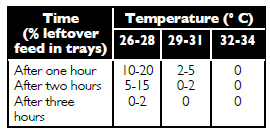The rates at which feed is consumed and digested by shrimp vary with the temperature of the culture environment as well as other factors. Laboratory research and subsequent field trials by the authors examined the effects of varied water temperature on the feeding process of Pacific white shrimp, Litopenaeus vannamei.

Laboratory Experiments
In laboratory experiments carried out
at Kasetsart University in Thailand, several
empty-gut shrimp with average
weights of 12 g were placed in aquariums
filled with filtered seawater for evaluation
of feed passage through the intestine at
experimental temperatures of 24, 26, 28,
30, 32 and 34 C, which resemble those
of common shrimp culture conditions.
Elapsed times at the following stages
were recorded:
- When feed was first observed in the gut
- At half-full gut
- At full gut, before feces were excreted
- Beginning of feces excretion
- Beginning of empty gut
- Fully empty gut.
Feed was applied at 3% body weight according to a feed table developed by Kasetsart University. Thus, feed was applied as 1% body weight for each of the three daily meals. Leftovers like feces, exuviae and uneaten feed were siphoned before each feed application.
Experimental Results
For most treatments, it took only five minutes to initially observe feed in the empty guts after feed ingestion, but significant differences in speed of digestion started to show later. For instance, it took up to 55 minutes at 24 versus 20 minutes at 34 C for the shrimps guts to become full. Once feces started to be excreted, differences increased even more, as this time went up to 105 minutes at 24 versus 35 minutes at 34 C. Results from all trials are compared in Table 1.
Field Trials
Evaluations of feed consumption
using feed trays at different temperatures
was done at the Golden Sun farm located
in Maoming, Guangdong, China, during
the summer and autumn cycles of 2010.
Trials were done in eight 0.25-ha
ponds stocked at 150 animals/m. Evaluations
started when feed consumption
increased strongly (at 6-g average weight
and feeding at 3.5% body weight) and
finished at harvest (14-g weight, 2.5%
body weight feeding).
A feed table was used as a reference
for feed doses, but feed tray readings
were given priority for feed adjustments
every day. Only 4% of the daily dose was
placed in the feed trays, and the rest was
broadcasted.
Feed was applied in equal doses to the
ponds at 6 a.m., 10 a.m., 3 p.m. and 6
p.m. at different temperatures. Temperature
was recorded before each dose, and
feed trays were checked one to three
hours after feed application. Feed doses
were increased to a ceiling of 30% above
the corresponding levels in the feed table.
Results grouped in three temperature
ranges (Table 2) showed that at 32 to 34
C, leftovers were never found, while at
ranges of 26 to 28 and 29 to 31, feed
consumption was considered in calculating
the appropriate feed doses.
Ranges of Time for Stages of Feed Passage Through Shrimp Intestines at Six Experimental Temperatures Under Laboratory Conditions.

Feeding At High Temperatures
During the summer cycle, it was
observed that feeding at 32 C or higher
could produce an excess proliferation of
phytoplankton, perhaps due to the high
amount of nutrients liberated from feed
and high accumulation of organic matter
on the bottom. Consequently, masses of
dead algae accumulated on the surface of
the ponds. This situation became dangerous
when excess feed increased the presence
of toxic compounds like nitrites and
the proliferation of Vibrio and other
pathogenic bacteria, causing mortalities
to shrimp.
It is worth mentioning that shrimp in
some ponds outside the trial that were fed
only 3 times/day had better feed conversion and survival than those in ponds fed
4 times/day, perhaps due to the deletion
of the dose at 3 p.m., when temperatures
peaked above 32 C. With less feed
applied, culture conditions improved, as
well as survival rate.
Consumption on Feed Trays at Different Temperature Ranges. Feed Doses were Calculated from a Feed Table using Complementary Information from Feed Tray Readings.

Perspectives
Nutritionists at Kasetsart University
have found that the ideal temperature for
the best digestibility of nutrients by
shrimp is between 29 and 31 C, which
coincides with the best range for feed
conversion observed in these trials.
According to the experiments described
here, shrimp digestion at temperatures
ranging from 24 to 28 C can take three
to four hours, indicating that intervals
between each feed dose should be perhaps
five to six hours to allow the complete
digestion and consumption of feed
for each dose.
On the other hand, at temperatures
higher than 32 C, digestion is much
faster, and feed consumption may be
higher. However, there is danger in
increasing feed doses to levels that can
bring higher organic matter concentrations
on pond bottoms, phytoplankton
blooms and large numbers of pathogenic
bacteria. Finally, it was noted that by
avoiding feeding at temperatures above
32 C, pond and production conditions
were improved.
May 2012




